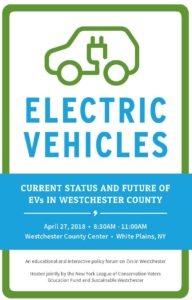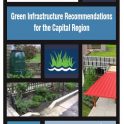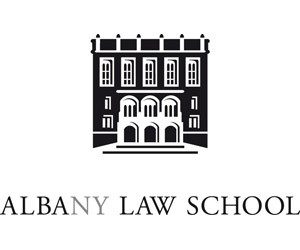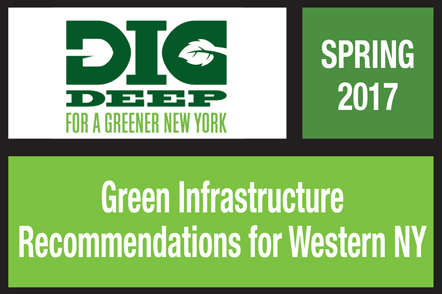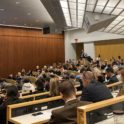
Last month, we joined Columbia Law School, The Earth Institute, and Assemblyman Daniel O’Donnell to host a policy forum on implementing the landmark Climate Leadership and Community Protection Act (CLCPA). Two panels of experts discussed the opportunities and challenges of implementing the new climate law.
The CLCPA is an ambitious plan for New York State to achieve 100% carbon-free electricity by 2040 and economy-wide carbon-neutrality by 2050. A minimum of 35% of clean energy and energy efficiency funds collected will be directed towards disadvantaged communities with a goal of 40% investment. In addition, this law requires that by 2050, New York its reduce greenhouse gas emission by 85% from its 1990 level.
The law is the nation’s most aggressive example of climate action and will serve as a model for other states to follow. The forum started with opening remarks from NYLCV President, Julie Tighe. She referred to the CLCPA as an enormous opportunity to not just reduce carbon emissions but to also address the inequity of our polluting past. All New Yorkers need to benefit from the transition to a green economy, and this law can ensure the communities that need resources can get them. The opportunity is enormous, but much work remains to ensure this law is implemented effectively.
Event co-hostAssemblyman Daniel O’Donnell welcomed the panelists and audiences to the 69th Assembly District, which he represents.
The theme of the first panel was “Curbing Emissions by Sector,” moderated by the founder and director of Andrew Sabin Center for Climate Change Law, Columbia Law School Professor, Michael B.Gerrard. Panelists included Natural Resource Defense Council’s Climate & Clean Energy Program Director, Jackson Morris, Ameresco’s Business Development Executive, Daniel Smith, The Nature Conservancy’s Policy and Strategy Director, Jessica Ottney, Regional Plan Association’s Senior Vice President of State Program and Advocacy, Kate Slevin, and Professor of the Columbia Graduate School of Architecture, Planning and Preservation (GSAPP), Craig Schwitter.
During panel one, panelists talked about our current sources of greenhouse gas emissions by major sectors including energy, transportation, and buildings, as well as overcoming the challenges each sector will face when meeting the CLCPA’s new standards. All the panelists agreed that the new law is ambitious, but an exciting opportunity.
Professor Gerrard introduced the sources of New York State’s greenhouse gas emissions by sector, including 33% from transportation, 15% from residential, 13% from electricity generation, 10% from commercial use, and more. He then presented an overview of the greenhouse gas and energy reduction goals of the CLCPA. He pointed out the major challenges in meeting renewable energy goals, including the closing of the Indian Point nuclear energy plant and increased electricity demands that will result from the electrification of transportation, heating, and cooling. Currently, New York derives less than 30% of its electricity from renewable sources like hydropower, solar, and wind. The rest comes from fossil fuels and nuclear power.
Morris also discussed the challenges in the electric power sector. One major challenge includes building the infrastructure quickly and in an environmentally responsible way. Another challenge is how to replace existing energy storage infrastructure that was built for fossil fuels with a substantial amount of battery storage in an economically-efficient and environmentally-friendly way.
Smith began by saying that renewable energy companies are looking forward to meeting the CLCPA’s requirements. He suggested that collaborations among industries, municipalities, universities, and decision-makers are critical to developing renewable energy plans.
Ottney discussed how communities, landowners, and local governments view clean energy, and said that we need to find a balance between renewable energy development, environmental protection, and community needs. She also talked about The Nature Conservancy’s effort to help the communities reduce emissions at a local scale.
Slevin underscored that transportation is the biggest contributor to climate change in both New York State and the country. She also talked about how the Transportation Climate Initiative will help reduce emissions from the transportation sector.
Schwitter stressed that buildings consume 40%-50% of the energy generated in the United States as well as in New York City, a majority of which is used for heating. Saving energy should be a top priority in designing new buildings. He also pointed out that our behaviors are as important as the building design, therefore we must take responsibility for saving energy.
The theme of the second panel was “Greening New York’s Economy,” moderated by professor of Columbia Graduate School of Architecture, Planning and Preservation, director of the Urban Planning Ph.D. program, Malo Hutson. Panelists included WEACT for Environment Justice’s Deputy Director, Cecil Corbin-Mark, IUOE Local 94’s Assistant Training Director, David Hawkins, Green City Force’s Chief Development Officer, Tonya Gayle, and New York Green Bank’s President, Alfred Griffin.
During this section, panelists discussed how the new law will affect the communities they represent. The CLCPA may create opportunities for the workforce, for green investment, and for investments in historically disadvantaged communities.
Corbin-Mark addressed the importance of including environmental and economic justice groups most impacted by climate change in the planning of policies and programs so that these communities can get the resources they need. He pointed out the opportunities CLCPA will bring, from engaging communities about environmental issues through a public health perspective, to creating pathways to green careers.
Hawkins talked about how the law affects engineers, a group that will be on the frontlines of making buildings more energy-efficient.
Gayle spoke about the experience of engaging young people living in public housing in the environmental movement, and how they can be leaders in their communities for reducing energy use and in taking advantage of educational opportunities in the green sector.
Griffin discussed how critical investment from the private sector is in achieving the CLCPA’s goals, and the role of the New York Green Bank in this transition to a green economy. Currently, Griffin said that investors are willing and looking to invest in sustainable technologies and infrastructure. He discussed how New York Green Bank finances some green developers’ projects at an early stage, helping the developers demonstrate their products to larger-scale investors so that more investors will participate. He also believes the collaboration between private and public sectors, good policies and regulatory regimes are critical to making the CLCPA financially successful
The forum concluded with remarks from Tighe about how his event will be one of a series of forums about the new climate law. Stay tuned for more information in the future. You can watch a video of the forum here.
Thank you again to our panelists and co-hosts for working with us on this event.






